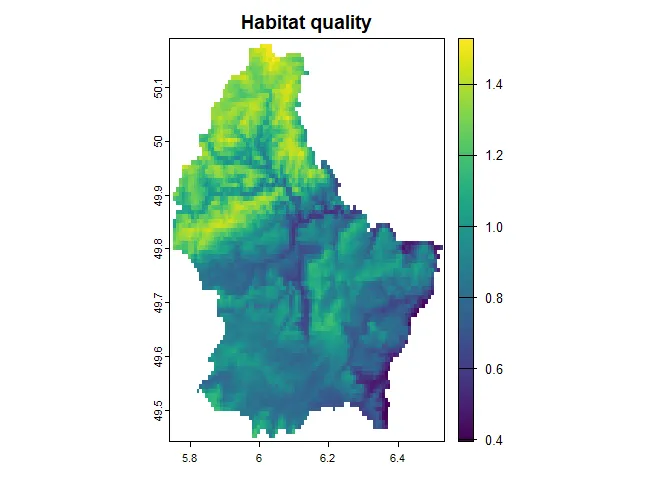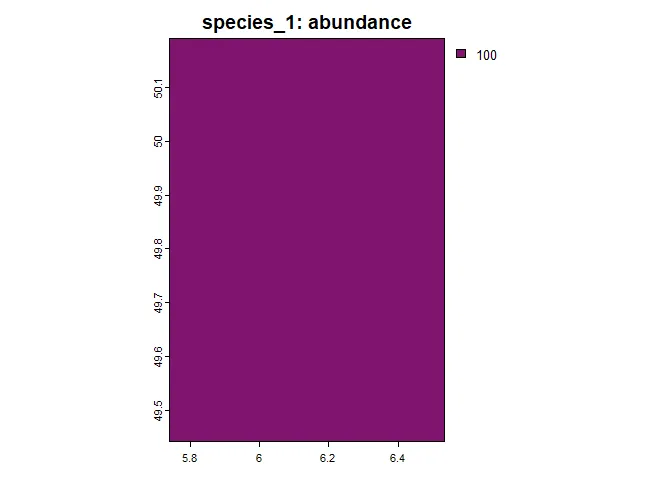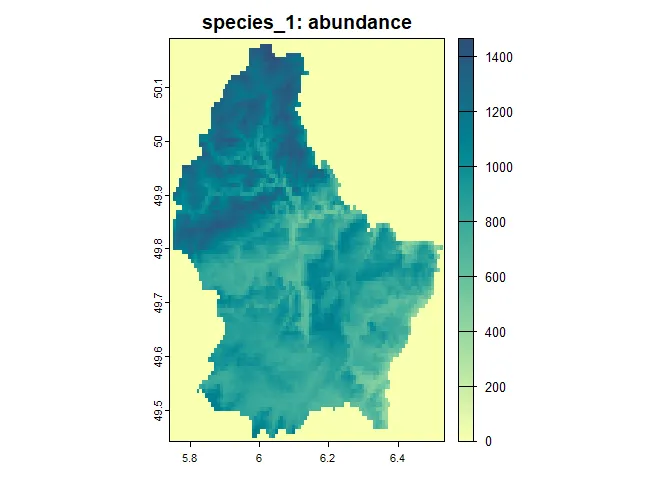Intro
metaRange is a framework to build a variety of different process
based species distribution models that can include a (basically)
arbitrary number of environmental factors, processes, species and
species interactions. The common denominator for all models built with
metaRange is that they are raster (i.e grid) and population based.
A metaRange simulation object contains one environment that holds
and manages all the environmental factors that may influence the
simulation (as raster data) and one or more species that are simulated
in the environment.
Each species object has two main characteristics: traits and
processes. Species traits can be (somewhat arbitrary) pieces of data
that describe and store information about the species while processes
are functions that describe how the species interacts with itself, time,
climate and other species. During each time step of the simulation, the
processes of the species are executed in a user defined order and can
access and modify the species traits.
While models built with metaRange can be quite variable in their
structure, they are all based on population dynamics. This means that in
most cases a trait will not be a single number but a matrix that has
the same size as the raster data in the environment, where each value
represents the trait value for one population in the corresponding grid
cell of the environment. Based on this, most processes will describe
population (and meta population) dynamics and not individual based
mechanisms. Figure 1 shows an example of some of the different
environmental factors, species traits and processes that could be
included in a simulation.
Figure 1: Example of some of the different environmental factors, species traits and processes that could be included in a simulation.
A more technical overview of the different components of a simulation
and how they interact with each other is shown in Figure 2. While the
environment has a temporal dimension (i.e. the different time steps, see
Fig.1), the traits (or the global variables of the simulation) have no
temporal property. They represent the state of the species (or of the
simulation respectively) in one (the current) time step. When a process
is executed within a time step, it can access this current state of the
simulation and modify it, which results in changing traits over the
course of the simulation. Each process can be assigned a priority that
is used by the process priority queue to determine in which order the
processes are executed within one time step.
Figure 2: Overview of the different components of a simulation and how
they interact with each other. Note that the number of species as well
as the number of traits and processes per species is not limited, but
only a selection is shown for simplicity.
Setting up a simulation
Section titled “Setting up a simulation”Following is a simple example of how to set up a simulation with
metaRange, in which we only use a single species and one environmental
factor (habitat quality). At the end of this introduction we will see
how the abundance of the species changes in relation to the quality of
the habitat each population occupies.
To start, we need to load the packages.
library(metaRange) # does the simulationlibrary(terra) # handles the raster data processingLoading the landscape
Section titled “Loading the landscape”The first step when setting up a simulation is the loading of the environment in which the simulation will take place. This can either be real world data or “theoretical” / generated data and may include for example different climate variables, land cover or elevation.
The simulation expects this data as an SpatRasterDataset (SDS) which
is a collection of different raster files that all share the same extent
and resolution. Each sub-dataset in this SDS represents one
environmental variable and each layer represents one time step of the
simulation. In other words, metaRange does not simulate the
environmental conditions itself, but expects the user to provide the
environmental data for each time step.
To create such a dataset one can use the function terra::sds(). One
important note: Since each layer represents the environmental condition
in one time step, all the raster files that go into the SDS need to
have the same number of layers (i.e. the desired number of time steps
the simulation should have). After the SDS is created, the individual
sub-datasets should be named, since this is how the simulation will
refer to them.
To simplify this introduction, we use an example landscape consisting
only of habitat quality data, with 10 time steps (layers) that are all
the same (i.e. no environmental change). Luckily the terra package has
a built-in demo that we can use for this purpose.
# find the fileraster_file <- system.file("ex/elev.tif", package = "terra")
# load itr <- rast(raster_file)
# scale itr <- scale(r, center = FALSE, scale = TRUE)plot(r, main = "Habitat quality")
Now we can turn this raster with one layer into an SDS that has
multiple layer (one for each time step).
r <- rep(r, 10)landscape <- sds(r)names(landscape) <- c("habitat_quality")landscape#> class : SpatRasterDataset#> subdatasets : 1#> dimensions : 90, 95 (nrow, ncol)#> nlyr : 10#> resolution : 0.008333333, 0.008333333 (x, y)#> extent : 5.741667, 6.533333, 49.44167, 50.19167 (xmin, xmax, ymin, ymax)#> coord. ref. : lon/lat WGS 84 (EPSG:4326)#> source(s) : memory#> names : habitat_qualityPre-setup
Section titled “Pre-setup”Before creating the simulation, it may be helpful to enable extensive reporting, which will print out a lot of information each time a metaRange function is called. This can be enabled or disabled at any time (i.e. also while the simulation is running), but in order to highlight what each function call in this tutorial does, we enable it at the beginning of the setup.
# 0 = no reporting# 1 = a bit of info# 2 = very verboseset_verbosity(2)Creating the simulation
Section titled “Creating the simulation”After the landscape is loaded, the simulation can be created using the
create_simulation() function. The only required argument is
source_environment which is the landscape / environment SDS that was
created in the first step. One can optionally specify an ID for the
simulation and a seed for the random number generator.
sim <- create_simulation( source_environment = landscape, ID = "example_simulation", seed = 1)#> number of time steps: 10#> time step layer mapping: 1, 2, 3, 4, 5, 6, 7, 8, 9, 10#> added environment#> class : SpatRasterDataset#> subdatasets : 1#> dimensions : 90, 95 (nrow, ncol)#> nlyr : 10#> resolution : 0.008333333, 0.008333333 (x, y)#> extent : 5.741667, 6.533333, 49.44167, 50.19167 (xmin, xmax, ymin, ymax)#> coord. ref. : lon/lat WGS 84 (EPSG:4326)#> source(s) : memory#> names : habitat_quality#>#> created simulation: example_simulationIf you want to inspect the simulation object, you can either print it,
to lists its fields and methods or use the summary() function to get
an overview of the simulation state.
sim#> metaRangeSimulation object#> Fields:#> $ID#> $globals#> $environment#> $queue#> $processes#> $seed#> Species: none#> Methods:#> $species_names()#> $add_globals()#> $add_species()#> $add_traits()#> $add_process()#> $begin()#> $exit()#> $set_time_layer_mapping()#> $get_time_layer_mapping()#> $get_current_time_step()#> $get_number_of_time_steps()#> $print()#> $summary()summary(sim)#> ID: example_simulation#> Environment:#> Fields:#> $current ==== the environment at the current time step#> classes : all -> matrix#> number : 1#> names : habitat_quality#> $sourceSDS == the source raster data of the environment#> class : SpatRasterDataset#> subdatasets : 1#> dimensions : 90, 95 (nrow, ncol)#> nlyr : 10#> resolution : 0.008333333, 0.008333333 (x, y)#> extent : 5.741667, 6.533333, 49.44167, 50.19167 (xmin, xmax, ymin, ymax)#> coord. ref. : lon/lat WGS 84 (EPSG:4326)#> source(s) : memory#> names : habitat_quality#> Time step layer mapping: 1 2 3 4 5 6 7 8 9 10#> Current time step: 1#> Seed: 1#> Species: 0#>#> Simulation level processes:#> NULL#> Gobal variables:#> NULL#> Queue:#> Remaining queue (this time step): 0#> NULL#> Future queue (next time step): 0#> NULLAdding species to the simulation
Section titled “Adding species to the simulation”Once the simulation is created, we can add species to it using the
add_species() function. At this point we have to switch to the syntax
of the R6 package
that metaRange uses. This means that add_species() is a method of the
simulation object and can be called using the $ operator (i.e. by
indexing the simulation object and calling a function that is stored
inside of it). The only required argument is names which is the
name(s) of the species that will be added.
sim$add_species("species_1")#> adding species#> name: species_1This species can now be accessed by using the $ operator again.
sim$species_1#> Species: species_1#> processes:#> NULL#> traits:#> character(0)Adding traits to species
Section titled “Adding traits to species”To assign traits to a species we can use use the add_traits() method.
The first argument is species which is a character vector of species
names that are already in the simulation, to which the trait should be
assigned to. The second argument is population_level, a TRUE/FALSE
value, that decides if the trait should be stored with one value per
population (i.e. as a matrix of the same size as the landscape) or not
(i.e. only one value per species). All following arguments can be
supplied in the form of trait_name = trait_value.
For now we only add three traits: abundance (number of individuals in
each population), reproduction_rate (how fast the populations can
reproduce) and carrying_capacity (maximum number of individuals per
grid cell). Note: Traits always represent the “current” state of a
species. This means that the abundance we use as input here represents
the initial state of the simulation. Over the course of the simulation
(i.e. in each time step) the traits can be updated and changed. In this
example, the abundance will change each time step while e.g. the
reproduction rate stays the same, but in other cases each trait might
change with time.
sim$add_traits( species = "species_1", population_level = TRUE, abundance = 100, reproduction_rate = 0.5, carrying_capacity = 1000 # ... # Note that here could be more traits, there is no limit)#> adding traits:#> [1] "abundance" "reproduction_rate" "carrying_capacity"#>#> to species:#> [1] "species_1"#>We can check what traits a species has by printing them:
sim$species_1$traits#> abundance : num [1:90, 1:95] 100 100 100 100 100 100 100 100 100 100 ...#> carrying_capacity : num [1:90, 1:95] 1000 1000 1000 1000 1000 1000 1000 1000 1000 1000 ...#> reproduction_rate : num [1:90, 1:95] 0.5 0.5 0.5 0.5 0.5 0.5 0.5 0.5 0.5 0.5 ...Or plotting them:
plot(sim$species_1, "abundance")
Note that the above plot is not very interesting, since the abundance is the same for each population at the beginning of the simulation.
Adding processes
Section titled “Adding processes”After the species and its traits are added, the processes that describe
how the species interacts with its environment can be added, using the
add_process() method. The arguments are: species which is again a
character vector of the species (names) that should receive the process,
process_name which is a human readable name for the process and
process_fun which is the function that will be called when the process
is executed.
One argument that might be confusing is the execution_priority. This
is a number that gives the process a priority “weight” and decides in
which order the processes are executed within one time step. The smaller
the number, the earlier the process will be executed (e.g. 1 gets
executed before 2). In the case two (or more) processes have the same
priority, it is assumed that they are independent from each other and
that their execution order does not matter.
Reproduction
Section titled “Reproduction”In this example we will only add a single process (reproduction) to
the species, that is going to calculate the abundance (for each
population) in the next time step, depending on the habitat quality. To
do so, we can use a built-in function ricker_reproduction_model() that
implements the “classic” Ricker reproduction model (Ricker, W.E. (1954))
[Ref. 1], which describes the population dynamics of a species with
non-overlapping generations in discrete time steps. This model features
density dependent growth and possibly also overcompensatory dynamics
(i.e. the populations can, if they have a high the reproduction rate,
become larger than the carrying capacity, which then leads to a decline
in the next time step).
Note the use of the self keyword in the function. In this context,
self refers to the species that the process is attached to. This means
that the function can access the species traits and modify them and also
access the environment (each species holds a reference to the simulation
it was created in).
sim$add_process( species = "species_1", process_name = "reproduction", process_fun = function() { # use a ricker reproduction model # to calculate the new abundance # and let the carrying capacity # depend on the habitat quality ricker_reproduction_model( self$traits$abundance, self$traits$reproduction_rate, self$traits$carrying_capacity * self$sim$environment$current$habitat_quality )
# print out the current mean abundance print( paste0("mean abundance: ", mean(self$traits$abundance)) ) }, execution_priority = 1)#> adding process: reproduction#> to species:#> [1] "species_1"#>Executing the simulation
Section titled “Executing the simulation”After the species, traits and processes are added to the simulation, it
can be executed via the begin() method.
sim$begin()#> Starting simulation.#> passed initial sanity checks.#> start of time step: 1#> |- species_1 : reproduction#> [1] "mean abundance: 84.1732579542268"#> |---- 0.00082 secs#> 10 % done | 0.012 secs remaining (estimate)#> start of time step: 2#> |- species_1 : reproduction#> [1] "mean abundance: 127.598064388471"#> |---- 0.0012 secs#> 20 % done | 0.065 secs remaining (estimate)#> start of time step: 3#> |- species_1 : reproduction#> [1] "mean abundance: 185.433176212344"#> |---- 0.00092 secs#> 30 % done | 0.049 secs remaining (estimate)#> start of time step: 4#> |- species_1 : reproduction#> [1] "mean abundance: 254.974925085775"#> |---- 0.00091 secs#> 40 % done | 0.045 secs remaining (estimate)#> start of time step: 5#> |- species_1 : reproduction#> [1] "mean abundance: 328.335965177599"#> |---- 0.0015 secs#> 50 % done | 0.039 secs remaining (estimate)#> start of time step: 6#> |- species_1 : reproduction#> [1] "mean abundance: 394.79908318955"#> |---- 8e-04 secs#> 60 % done | 0.027 secs remaining (estimate)#> start of time step: 7#> |- species_1 : reproduction#> [1] "mean abundance: 446.224976588256"#> |---- 0.00094 secs#> 70 % done | 0.024 secs remaining (estimate)#> start of time step: 8#> |- species_1 : reproduction#> [1] "mean abundance: 480.705159122178"#> |---- 9e-04 secs#> 80 % done | 0.022 secs remaining (estimate)#> start of time step: 9#> |- species_1 : reproduction#> [1] "mean abundance: 501.356439544315"#> |---- 7e-04 secs#> 90 % done | 0.006 secs remaining (estimate)#> start of time step: 10#> |- species_1 : reproduction#> [1] "mean abundance: 512.803082103058"#> |---- 0.00088 secs#> 100 % done | 0 secs remaining (estimate)#>#> Simulation: 'example_simulation' finished#> Exiting the Simulation#> Runtime: 0.08 secsPlotting the results
Section titled “Plotting the results”To investigate the results visually, you can just use plot().
# define a nice color paletteplot_cols <- hcl.colors(100, "BluYl", rev = TRUE)plot( sim, obj = "species_1", # name of the species name = "abundance", # name of the trait to plot main = "Species 1: abundance", # optional title col = plot_cols # color palette)
Saving the simulation
Section titled “Saving the simulation”If you want to save the results (or any intermediate data) of the
simulation, you can use the save_species() function. This will save
the (possibly specified) traits of a species, either as a raster (.tif)
or as a text (.csv) file, whatever is more appropriate for the data.
Note that this function does not save the species processes. One
should keep a copy of the script that is used to run the simulation to
make it repeatable.
save_species( sim$species_1, traits = c("name", "of", "one_or_more", "traits"), path = "path/to/a/folder/")References
Section titled “References”- Ricker, W.E. (1954) Stock and recruitment. Journal of the Fisheries Research Board of Canada, 11, 559–623. doi:10.1139/f54-039
